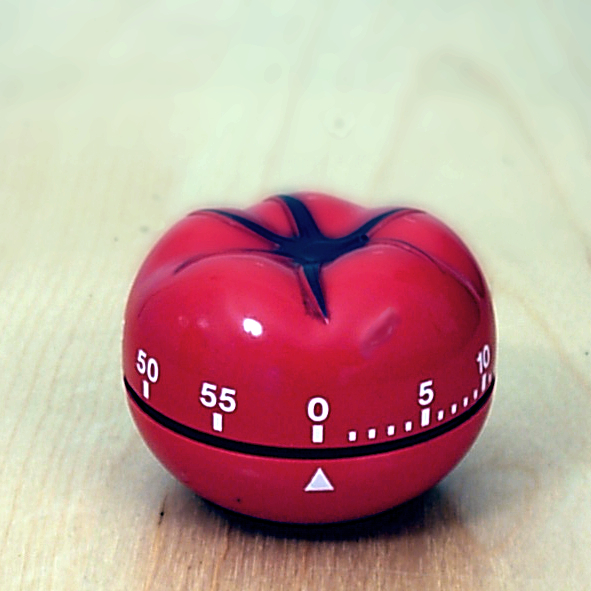Pomodoro Technique on:
[Wikipedia]
[Google]
[Amazon]
 The Pomodoro Technique is a
The Pomodoro Technique is a
 The Pomodoro Technique is a
The Pomodoro Technique is a time management
Time management is the process of planning and exercising conscious control of time spent on specific activities—especially to increase effectiveness, efficiency and productivity.
Time management involves demands relating to work, social ...
method developed by Francesco Cirillo in the late 1980s. It uses a kitchen timer
An egg timer or kitchen timer is a device whose primary function is to assist in timing during cooking; the name comes from the first timers initially being used for the timing of cooking eggs. Early designs simply counted down for a specific p ...
to break work into intervals, typically 25 minutes in length, separated by short breaks. Each interval is known as a ''pomodoro'', from the Italian word for tomato
The tomato (, ), ''Solanum lycopersicum'', is a plant whose fruit is an edible Berry (botany), berry that is eaten as a vegetable. The tomato is a member of the nightshade family that includes tobacco, potato, and chili peppers. It originate ...
, after the tomato-shaped kitchen timer that Cirillo used while a university student.
Apps and websites providing timers and instructions have widely popularized the technique. Closely related to concepts such as timeboxing
In agile principles, timeboxing allocates a maximum unit of time to an activity, called a timebox, within which a planned activity takes place. It is used by agile principles-based project management approaches and for personal time management. ...
and iterative and incremental development
Iterative and incremental development is any combination of both iterative design (or iterative method) and incremental build model for New product development, development.
Usage of the term began in software development, with a long-standing com ...
used in software design, the method has been adopted in pair programming
Pair programming is a software development technique in which two programmers work together at one workstation. One, the ''driver'', writes code while the other, the ''observer'' or ''navigator'', reviews each line of code as it is typed in. Th ...
contexts.
Description
The original technique has six steps: # Decide on the task to be done. # Set the Pomodoro timer (typically for 25 minutes). # Work on the task. # End work when the timer rings and take a short break (typically 5–10 minutes). Click the "how" link and see step 4. Presumably, the piece of paper can be one's task list or similar. In any case, four check marks indicate a longer break (step 6). # Go back to Step 2 and repeat until you complete four pomodori. # After four pomodori are done, take a long break (typically 20 to 30 minutes) instead of a short break. Once the long break is finished, return to step 2. For the purposes of the technique, a ''pomodoro'' is an interval of work time (and ''pomodori'' is the plural form). A goal of the technique is to reduce the effect of internal and external interruptions offocus
Focus (: foci or focuses) may refer to:
Arts
* Focus or Focus Festival, former name of the Adelaide Fringe arts festival in East Australia Film
*Focus (2001 film), ''Focus'' (2001 film), a 2001 film based on the Arthur Miller novel
*Focus (2015 ...
and flow. A pomodoro is indivisible; when interrupted during a Pomodoro, either the other activity must be recorded and postponed (using the ''inform – negotiate – schedule – call back'' strategy) or the pomodoro must be abandoned.
After task completion in a Pomodoro, any remaining time should be devoted to activities; for example:
# Review the work you just completed (optional)
# Review the activities from a learning point of view (ex: What learning objective did you accomplish? What learning outcome did you accomplish? Did you fulfill your learning target, objective, or outcome for the task?)
# Review the list of upcoming tasks for the next planned pomodoro time blocks, and start reflecting on or updating them.
Cirillo suggests:
The stages of planning, tracking, recording, processing and visualizing are fundamental to the technique. In the planning phase, tasks are prioritized by recording them in a "To Do Today" list, enabling users to estimate
Estimation (or estimating) is the process of finding an estimate or approximation, which is a value that is usable for some purpose even if input data may be incomplete, uncertain, or unstable. The value is nonetheless usable because it is de ...
the effort they will require. As pomodori are completed, they are recorded, adding to a sense of accomplishment and providing raw data for subsequent self-observation and improvement.
Tools
The creator and his proponents encourage a low-tech approach, using a mechanical timer, paper, and pencil. The physical act of winding the timer confirms the user's determination to start the task; ticking externalizes the desire to complete the task; ringing announces a break. Flow and focus become associated with these physical stimuli. The technique has inspiredapplication software
Application software is any computer program that is intended for end-user use not operating, administering or programming the computer. An application (app, application program, software application) is any program that can be categorized as ...
for several platforms, with various programs available.
See also
* Body doubling * Incremental reading *Life hack
A life hack (or life hacking) is any trick, shortcut, skill, or novelty method that increases productivity and efficiency, in all walks of life. The term was primarily used by computer experts who suffer from information overload or those with a p ...
ing
* Procrastination
Procrastination is the act of unnecessarily delaying or postponing something despite knowing that there could be negative consequences for doing so. It is a common human experience involving delays in everyday chores or even putting off tasks such ...
References
{{Reflist Personal development Personal time management time management